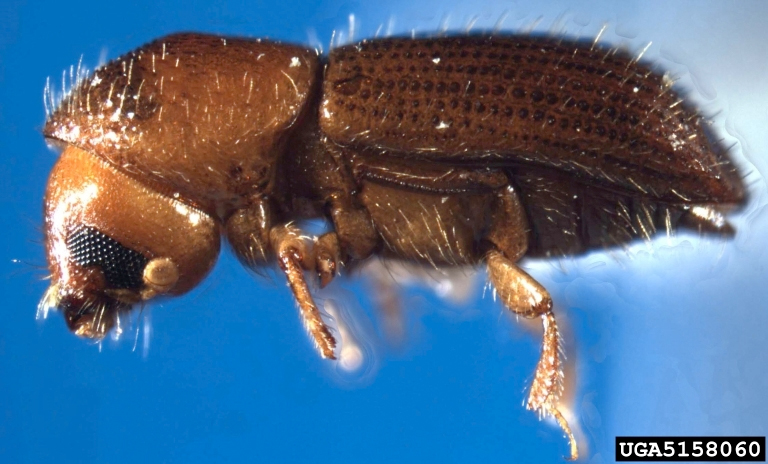Ambrosia beetles are beetles of the weevil subfamilies Scolytinae and Platypodinae (Coleoptera, Curculionidae), which live in nutritional symbiosis with ambrosia fungi and probably with bacteria.
The beetles excavate tunnels in dead or live trees in which they cultivate fungal gardens, their sole source of nutrition.
Ambrosia beetles are sometimes referred to as Shot Hole Borers.
After landing on a suitable tree, an ambrosia beetle excavates a tunnel in which it releases spores of its fungal symbiont. The fungus penetrates the plant’s xylem tissue, digests it, and concentrates the nutrients on and near the surface of the beetle gallery.
The majority of ambrosia beetles colonize xylem (sapwood and/or heartwood) of dying or recently dead trees, but some attack live trees.
Species differ in their preference for different parts of trees, different stages of deterioration, and in the shape of their tunnels (“galleries”). However, the majority of ambrosia beetles are not specialized to any taxonomic group of hosts, unlike most phytophagous organisms including the closely related bark beetles. One species of ambrosia beetle, Austroplatypus incompertus exhibits eusociality, one of the few organisms outside of Hymenoptera to do so.
Another Species of Ambrosia beetle causing very serious concern and damage in California is the “Polyphagous shot hole borer (PSHB)”.
Symbiotic Relationship
Beetles and their larvae graze on mycelium exposed on the gallery walls and on bodies called sporodochia, clusters of the fungus’ spores. Most ambrosia beetle species don’t ingest the wood tissue; instead, the sawdust resulting from the excavation is pushed out of the gallery. Following the larval and pupal stage, adult ambrosia beetles collect masses of fungal spores into their mycangia and leave the gallery to find their own tree.
A few dozen species of ambrosia fungi have been described, currently in the polyphyletic genera Ambrosiella (mostly Microascales), Raffaelea, Ceratocystiopsis and Dryadomyces (from Ophiostomatales), Ambrosiozyma (yeasts), and Entomocorticium (Basidiomycota). Many more species remain to be discovered. Little is known about the bionomy or specificity of ambrosia fungi. Ambrosia fungi are thought to be dependent on transport and inoculation provided by their beetle symbionts, as they have not been found in any other habitat. All ambrosia fungi are probably asexual and clonal.[3] Some beetles are known to acquire (“steal”) fungal inoculum from fungal gardens of other ambrosia beetle species.


